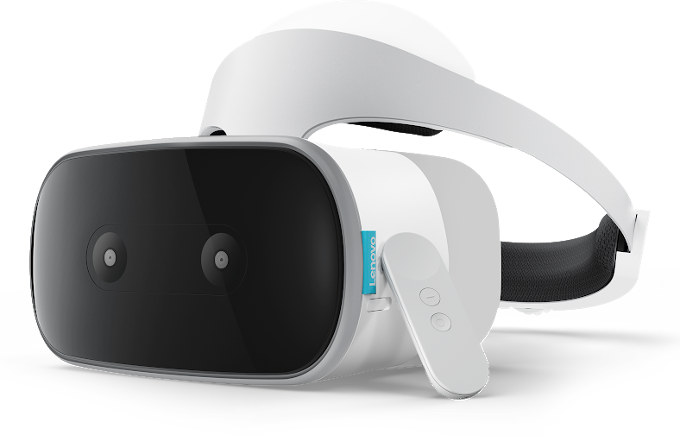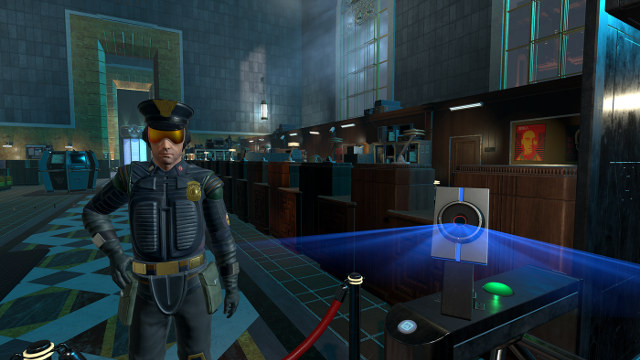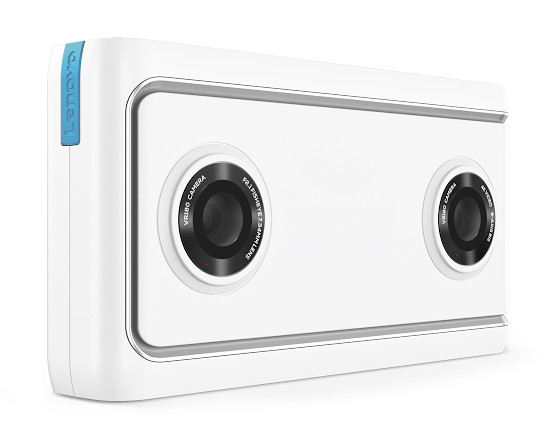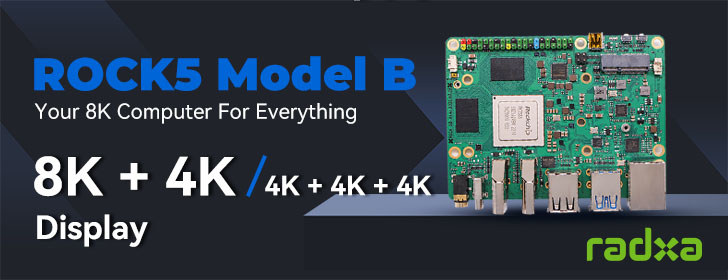Standalone / All-in-One Android virtual reality headsets have been around for a couple of years, mostly from Chinese vendors. But the number and quality of VR apps available were rather low at the time, and those VR headsets were mostly useful to watch 360° & VR videos.
This may explain why larger companies had not launched any standalone headset so far, but this week everything changed, as Facebook started selling their Oculus Go virtual reality headset , and Google & Lenovo have just jointly announced the availability of Mirage Solo, the first standalone VR headset compatible with Google Daydream.
 Lenovo Mirage Solo specifications:
Lenovo Mirage Solo specifications:
- SoC- Qualcomm Snapdragon 835 VR processor
- System Memory – 4 GB RAM
- Storage – 64 GB UFS flash, microSD Card slot up to 256 GB
- Display – 5.5″ QHD (2560 x 1440) LCD display @ 75 Hz
- Lenses – 2 x Fresnel-Aspheric 110° FOV
- Camera – Dual 6-Degrees-of-Freedom Tracking Cameras
- Controls – 3 DOF Wireless Daydream Motion Controller
- Headset Buttons – I/O, Volume Key, Adjustment Dial, Quick Release Button
- Sensors – P-Sensor, Gyroscope, Accelerometer, Magnetometer
- Audio – Android N Pro Audio, 3.5mm audio jack with dual microphones
- Connectivity – Dual Band WiFi 802.11 ac/n 2×2 MIMO , Bluetooth 5 LE
- Battery – 4,000 mAh Li-ion Polymer battery good for around 2.5 hours
- Dimensions – 204 mm x 269.5 mm x 179.86 mm
- Weight – 645 g
The headset runs Android based Daydream 2.0 operating system with Lenovo OOBE (Out Of Box Experience), ePOS, YouTube, Google Arts & Culture, Google Photos, Google Play Movies & TV, and Google Street View apps pre-installed. Over 350 games & apps can also be installed including Blade Runner: Revelations, Extreme Whiteout, Narrows, BBC Earth Live in VR, Fire Escape, Eclipse: Edge of Light, Virtual Virtual Reality, Merry Snowballs, and Rez Infinite.

Beside the headset, the kit also includes a wireless daydream motion controller, a travel adapter, a USB Type-C cable, 3.5 mm VR optimized earphones, a user manual, a Quick Start Guide, and a warranty card.
The companies also launched Lenovo Mirage Camera, which they claim is the the first VR180 consumer camera, and allows end-users to easily capture VR content – just as they’d do with point and shoot camera – to watch them latter on their Mirage Solo headset using YouTube and/or Google Photo.
- SoC- Qualcomm Snapdragon 626 processor
- System Memory – 2 GB RAM
- Storage – 16 GB eMMC flash, microSD card slot up to 128 GB
- Camera
- Dual 13 MP sensor
- Aperture: F/2.1
- FOV: 180° x 180°
- Video / Photo
- 4K/1440P/1080P @ 30 FPS
- VR Jpeg – pictures – (dual) equi-rectangular
- VR Mp4 – videos – dual fisheye format
- Audio – Dual microphones, single speaker
- Connectivity – 802.11ac WiFi, Bluetooth 4.2 + BLE
- Sensors – IMU Sensor (6 Degrees of Freedom)
- Misc – Power on/off, function, and shutter buttons
- Battery – Removable 2200 mAh Li-ion polymer battery working up to 2 hours
- Charger – 5V/1A USB Type-C
- Dimensions – 55 mm x 105 mm x 22 mm
- Weight – 139 grams
The camera ships with a 5 V/ 1 A wall adapter, a USB Type-C cable, two LiPo batteries (one for backup), a user manual, a pouch for camera lens protection and cleaning, a Quick Start Guide, and a warranty card.
Lenovo Mirage Solo Daydream VR headset sells for $399.99, while Mirage camera goes for $299.99.

Jean-Luc started CNX Software in 2010 as a part-time endeavor, before quitting his job as a software engineering manager, and starting to write daily news, and reviews full time later in 2011.
Support CNX Software! Donate via cryptocurrencies, become a Patron on Patreon, or purchase goods on Amazon or Aliexpress





So one thing I can’t find info on is, are the “Lenovo Mirage Solo”‘s cameras only for 6DOF – or can they be used to do AR? (ie. passed through to the screens and then overlayed with whatever you want) Can you at least take 3D photos with them?
There’s going to be lag. How much remains to be seen, but it’s probably enough to preclude AR. Really, unless you’re doing recog or other processing of the environmental visuals, you don’t want to even DO that sort of thing and are better off with other solutions. We’ll see if AntVR’s AR solution sees the light of day and is as impressive as claimed- if so, you’ll want to just simply FORGET the notion there.
Does this actual taken video interest anyone?
https://m.youtube.com/watch?v=TH_MMXinRsA&time_continue=84
I wonder what they will be able to do with 6DoF for standalones and how it will look in comparison with PC VR.
Guess we’ll see when they ship the thing. I know the fit and finish of the Oculus GO is impressive, even if the battery life is a bit wanting (About 2.5-3.5 hours of continuous use. I’m seeing 2 hours, 45 minutes playing Republique VR on mine.) Oculus only failing? That walled garden they insist upon. But they do seem to have a few actual, “killer games” and apps in the same. so I don’t feel took at $250 for the comparable Go unit to this unit.